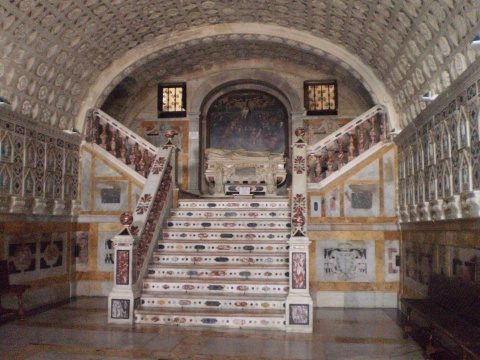The 179 niches of the crypt were discovered during excavations carried out under the presbytery by the will of the archbishop de Esquivel, at the beginning of the 17th century. Above each niche there is a marble bas-relief panel of the saint with its name and the symbols of martyrdom. The Sanctuary, entirely excavated on the living rock, was inaugurated on November 27, 1618, after a solemn procession with the relics of the Martyrs, in the presence of religious and civil authorities and with the participation of all the Christian people. In the Sanctuary, there are architectural and artistic elements of the Renaissance, Baroque and Neoclassicism. On the landing that is located under the marble stairs leading to the Sanctuary, there is the marble sarcophagus of the archbishop Francisco de Esquivel, made by Antonio Zelpi, and a 17th century Spanish school painting depicting the Crucifixion on which the same archbishop and martyrs from Cagliari. On the sides of the sarcophagus there are also two plaques commemorating the erection and consecration of the Sanctuary on 11 November 1618, and the translation of the relics, which took place on 27 November of the same year.
The Martyrs' Sanctuary consists of three rooms:
in the Central Chapel or of the “Madonna dei Martiri” there are 66 niches. Above the altar there is a statue of the “Madonna and Child and San Giuseppe and Sant'Anna” on the sides. Above the two side doors two plaques commemorate the responses of Pope Paul V and the king of Spain Philip III to the discovery of the relics.
In the Chapel of San Lucifero, dedicated to the homonymous bishop of Cagliari, there are 80 niches. The bones of the saint, found on June 21, 1623 and moved on May 20, 1626, are placed under the altar table; above the altar is instead placed his statue. Above the entrance door are posted the original inscription, which was located in the saint's tomb and the triangular piece of marble found on the bishop's chest. In the chapel there is also a Roman sarcophagus containing the bones of Saint Antiochus and the white marble mausoleum of Maria Giuseppina di Savoia, wife of Louis XVIII king of France, who died in exile in London in 1810 and moved to Cagliari, to his will, in 1811.
The Chapel of Saint Saturnino, dedicated to the patron saint of the city of Cagliari, was built around 1620 and contains 33 niches. Above the altar, a 2nd century Roman sarcophagus (found in 1621 in the basilica of Saint Saturnino) preserves the saint's relics. Above it, in a niche, there is the statue of Saint Saturnino. Inside the chapel there are two other Roman sarcophagi: one located above the entrance door which contains relics of 10 saints, the other placed on the wall behind the monument dedicated to Carlo Emanuele di Savoia contains relics of 9 saints. At the end of the chapel there is the mausoleum of Carlo Emanuele di Savoia, who died of smallpox at the age of two. The monument, built in 1799, is the work of Antonio Cano. Above, two marble lunettes made in the early eighteenth century depict San Pietro and the Madonna del Carmine.
Cripta della Cattedrale di Santa Maria
Cripta della Cattedrale di Santa Maria
Piazza Palazzo
City
CagliariAdd new review
Your review will be visible after approval by the editors
To post a review you must be an authenticated user.
Log in with Social Login
